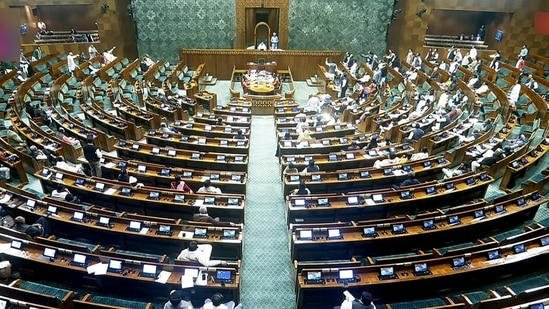New Delhi, December 2024: In a landmark political development, the One Nation, One Election bill, officially known as the Constitution (One Hundred and Twenty-Ninth Amendment) Bill, 2024, is set to be introduced today in the Lok Sabha. Union Law Minister Arjun Ram Meghwal is expected to table the bill during the ongoing Winter Session of Parliament, which began on November 25 and is scheduled to conclude on December 20.
The bill proposes a major overhaul in India’s electoral process, seeking to synchronize elections for the Lok Sabha and State Assemblies, ensuring that polls across the country are held simultaneously. This initiative has sparked intense political debates, with the ruling Bharatiya Janata Party (BJP) strongly advocating for the move while the opposition, led by the Congress party, has raised significant concerns over its impact on India’s federal structure and democratic ethos.
As the nation awaits this pivotal moment, we take an in-depth look at the One Nation, One Election proposal, its historical roots, the arguments for and against it, and the potential implications it may have on India’s democracy.
What is the ‘One Nation, One Election’ Bill?
The One Nation, One Election bill seeks to align the electoral cycles of the Lok Sabha (Parliamentary elections) and all State Assemblies, ensuring that citizens vote for their national and state representatives on the same day. This means that elections, which currently occur separately at varying intervals, could be streamlined into a single, synchronized process.
If passed, the bill will bring amendments to key articles of the Constitution, including:
- Article 83 (Duration of the Lok Sabha)
- Article 85 (Dissolution of the Lok Sabha)
- Article 172 (Duration of State Legislatures)
- Article 174 (Dissolution of State Assemblies)
- Article 356 (President’s Rule in States)
This ambitious reform will require both procedural and structural changes to India’s democratic framework, including the adjustment of assembly terms to align with the proposed synchronized timeline.
Historical Context: When India Had Simultaneous Elections
Simultaneous elections are not new to India. From 1952 to 1967, elections for the Lok Sabha and State Assemblies were held concurrently. This system functioned smoothly during the early years of India’s independence.
However, the electoral alignment began to unravel due to political instability and frequent dissolutions of State Assemblies in the late 1960s. States such as Haryana and West Bengal witnessed premature dissolution of their governments, breaking the synchronized cycle.
By the mid-1970s, staggered elections became the norm, leading to the current system where assembly elections take place at different times, often overlapping with the five-year Lok Sabha cycle.
Developments and Political Reactions
The introduction of the One Nation, One Election bill has generated sharp divisions across political parties:
1. BJP’s Support
The Bharatiya Janata Party (BJP), which is spearheading the initiative, has argued that simultaneous elections will bring several benefits, including:
- Reduction in Electoral Costs: Conducting elections at different intervals requires substantial financial and human resources. The BJP claims that synchronized polls will minimize expenses for both the Election Commission and political parties.
- Administrative Efficiency: Frequent elections disrupt governance due to the implementation of the Model Code of Conduct (MCC), which restricts policy announcements and decision-making. Simultaneous elections will ensure continuity in administration.
- Focus on Development: With elections occurring every few months, political leaders are often engaged in campaigns rather than governance. A unified election schedule could allow governments to focus on long-term development goals.
BJP spokespersons have also reminded the public that simultaneous elections were the norm until 1967 and have been recommended by multiple expert committees over the years.
2. Congress Opposition
The Congress party has strongly opposed the bill, citing concerns over its implications for India’s federal structure and democratic processes.
Congress MP Manish Tewari has been vocal in his criticism, arguing that synchronized elections could undermine the autonomy of State Assemblies. “The Constitution guarantees federalism, where states function as independent political entities. By forcing simultaneous elections, we risk centralizing power and weakening state governance,” Tewari stated.
The Congress party has issued a whip, mandating the attendance of all its Lok Sabha MPs during today’s session, reflecting the seriousness of their opposition.
3. Other Political Parties
Other regional parties have reacted cautiously:
- Shiv Sena and other allies have issued similar directives to ensure full attendance during the bill’s discussion.
- Trinamool Congress (TMC) and Dravida Munnetra Kazhagam (DMK) have echoed concerns about federalism and the potential loss of regional political identity.
- Biju Janata Dal (BJD) and YSR Congress Party have maintained a neutral stance, awaiting further clarity on the bill’s provisions.
Arguments For and Against the Bill
Arguments in Favor
- Cost Savings
The cost of conducting elections in India is enormous. In the 2019 Lok Sabha elections, the Election Commission spent nearly ₹8,000 crore. Conducting state assembly elections separately adds to this financial burden. Proponents argue that a synchronized system will drastically reduce expenditure on logistics, security, and manpower. - Reduced Disruption to Governance
Frequent elections stall governance due to the imposition of the Model Code of Conduct. This impacts policymaking and project implementation. A single election cycle will allow governments to function without interruptions. - Improved Voter Turnout
Simultaneous elections may boost voter participation, as citizens would cast votes for both Lok Sabha and State Assemblies in a single event. Studies have shown that combined elections could simplify the voting process for the electorate. - Strengthened National Focus
Advocates believe that holding elections simultaneously would reduce the perpetual political campaign mode, allowing governments to focus on national and state-level developmental agendas.
Arguments Against
- Threat to Federalism
Critics argue that One Nation, One Election undermines the principles of federalism enshrined in the Constitution. State Assemblies may lose their independence, as their terms would need to align with the Lok Sabha. This could lead to a centralized political system, overshadowing regional issues and leadership. - Logistical Challenges
Holding elections simultaneously for a country as vast and diverse as India poses significant logistical challenges. The deployment of security forces, election officials, and infrastructure on such a large scale would be an enormous undertaking. - Impact on Accountability
In a synchronized system, governments that lose the confidence of the people mid-term would face delays in holding fresh elections. Critics fear this could reduce the accountability of elected representatives. - Overwhelming the Voter
Simultaneous elections could create voter fatigue, with citizens required to make decisions for both state and national governments at the same time. This may lead to less-informed voting choices. - Technical Amendments
Aligning elections would require massive constitutional and legal amendments, including the adjustment of assembly terms, extension of existing terms, or premature dissolution of some state assemblies. This raises questions about fairness and feasibility.
The Road Ahead: Potential Impact of the Bill
If passed, the One Nation, One Election bill will reshape India’s electoral landscape. While it promises efficiency, cost savings, and administrative continuity, it also poses challenges to India’s federal structure and democratic flexibility.
Implications for Political Parties
- National parties like the BJP and Congress may benefit from synchronized elections, as they can streamline their campaigns and resources across states.
- Regional parties, however, may face disadvantages, as their issues could be overshadowed by national narratives.
Impact on Governance
Simultaneous elections could improve policy continuity and reduce distractions for policymakers. However, the inability to hold midterm polls could create governance gaps in states where governments collapse or lose majority support.
Public and Expert Reactions
The proposal has sparked mixed reactions from constitutional experts, political analysts, and citizens:
- Constitutional expert Fali Nariman emphasized the importance of preserving India’s federal spirit, warning against any measures that could centralize power.
- In contrast, political analyst Pratap Bhanu Mehta noted that while logistical challenges exist, the bill could be a step toward improving governance efficiency.
Citizens, too, remain divided. While many support the idea of cost savings and reduced election fatigue, others fear it could undermine regional representation and accountability.
A Defining Moment for Indian Democracy
As the One Nation, One Election bill takes center stage in Parliament, it represents a defining moment for Indian democracy. Its introduction has reignited debates on electoral reforms, federalism, and governance efficiency.
For the ruling BJP, the bill is a bold attempt to modernize India’s electoral system, reducing costs and administrative hurdles. For the opposition, it is a threat to the foundational principles of federalism and state autonomy.
The fate of this historic proposal will not only determine the future of India’s elections but also test the resilience of its democracy. Will the country embrace a unified electoral process, or will the challenges outweigh the benefits?



